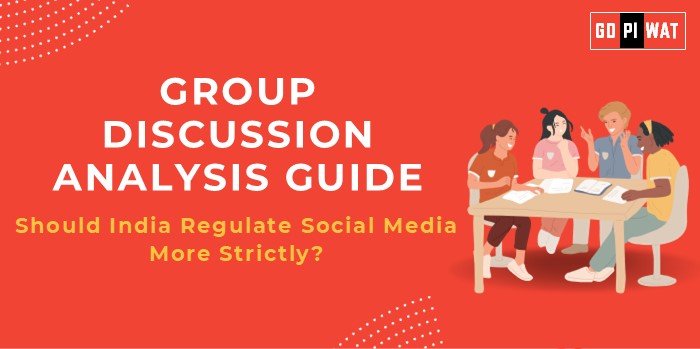📋 Group Discussion (GD) Analysis Guide: Should India Regulate Social Media More Strictly?
🌐 Introduction to the Topic
- 📜 Opening Context: “With over 900 million internet users, India’s digital landscape is vast and dynamic, making the regulation of social media a critical and timely issue.”
- 📖 Background: The proliferation of misinformation, hate speech, and privacy concerns on platforms like Facebook, X (formerly Twitter), and Instagram has intensified debates about the necessity and extent of social media regulation in India.
📊 Quick Facts and Key Statistics
- 🌍 Internet Users in India: Approximately 900 million as of 2024, highlighting the extensive reach of social media platforms.
- 👥 Social Media Users: 462 million active users, constituting 32.2% of the population, indicating significant engagement.
- ⚠️ Digital Misinformation: A 67% increase in fake news complaints in 2023, underscoring the urgency for effective regulation.
- 📜 Regulatory Framework: The Information Technology (Intermediary Guidelines and Digital Media Ethics Code) Rules, 2021, introduced to enhance accountability among social media platforms.
- 🌍 Global Comparison: The European Union’s Digital Services Act (2022) serves as a benchmark for stringent social media governance.
👥 Stakeholders and Their Roles
- 🏛️ Government: Formulates and enforces policies to regulate content and ensure compliance with national laws.
- 💻 Social Media Companies: Implement content moderation policies, ensure user data protection, and comply with local regulations.
- 🙋♂️ Users: Engage responsibly on platforms, report inappropriate content, and adhere to community guidelines.
- 🌐 Civil Society Organizations: Advocate for free speech, privacy rights, and ethical regulations, ensuring a balance between regulation and freedom.
- 🌍 International Bodies: Provide guidelines and frameworks for best practices in digital governance.
🏆 Achievements and Challenges
✅ Achievements
- 📜 Enhanced Accountability: The IT Rules 2021 mandated the appointment of grievance officers and established timelines for addressing user complaints, leading to more responsive platforms.
- 🤝 Content Moderation Initiatives: Collaborations with fact-checking organizations have been established to curb misinformation.
- 👥 User Empowerment: Introduction of tools for users to report and flag inappropriate content, fostering a safer online environment.
⚠️ Challenges
- 📜 Ambiguity in Regulations: Certain provisions of the IT Rules 2021 have been criticized for being vague, potentially leading to overreach and impacting free speech.
- 🛠️ Compliance Burden: Smaller platforms may struggle with the resource-intensive requirements of compliance, potentially stifling innovation.
- 🌍 Global Comparisons: While the EU has implemented comprehensive regulations, India’s diverse and large user base presents unique challenges in enforcement.
- 📉 Case Study: During the 2021 Farmers’ Protests, social media platforms faced government directives to block certain content, highlighting the tension between regulation and freedom of expression.
📄 Structured Arguments for Discussion
- ✅ Supporting Stance: “Implementing stricter regulations on social media is essential to curb the spread of misinformation and protect societal harmony.”
- ❌ Opposing Stance: “Excessive regulation may infringe upon free speech and hinder the democratic discourse that social media facilitates.”
- ⚖️ Balanced Perspective: “While regulation is necessary to address harmful content, it must be carefully crafted to preserve freedom of expression and encourage innovation.”
💡 Effective Discussion Approaches
- 📊 Statistical Approach: “With 462 million active social media users in India, the potential for both positive engagement and misuse is immense, necessitating a discussion on regulation.”
- 📜 Case Study Example: “The proliferation of misinformation during the COVID-19 pandemic highlighted the critical need for effective social media regulation.”
💬 Counter-Argument Handling
- 💡 Acknowledge the importance of free speech but emphasize the need for responsible usage and the role of regulation in mitigating harm.
🔎 Strategic Analysis of Strengths and Weaknesses
- 💪 Strengths: Large and engaged user base, robust IT infrastructure, and a tradition of democratic discourse.
- ❌ Weaknesses: Digital literacy gaps, potential for regulatory overreach, and challenges in enforcing regulations across diverse platforms.
- 🌟 Opportunities: Leveraging AI for content moderation, fostering public-private partnerships, and setting global standards in digital governance.
- ⚠️ Threats: Rising cybercrimes, potential suppression of dissent, and the risk of stifling innovation through overregulation.
🎓 Connecting with B-School Applications
📊 Real-World Applications
- 🛍️ Exploring the impact of social media regulation on digital marketing strategies, corporate communication, and crisis management.
💬 Sample Interview Questions
- 💭 “How can businesses adapt their social media strategies in light of stricter regulations?”
- 📜 “What role does corporate social responsibility play in managing a company’s presence on social media platforms?”
💡 Insights for Students
- 📚 Understanding the balance between regulation and innovation is crucial for future leaders in navigating the digital economy.


